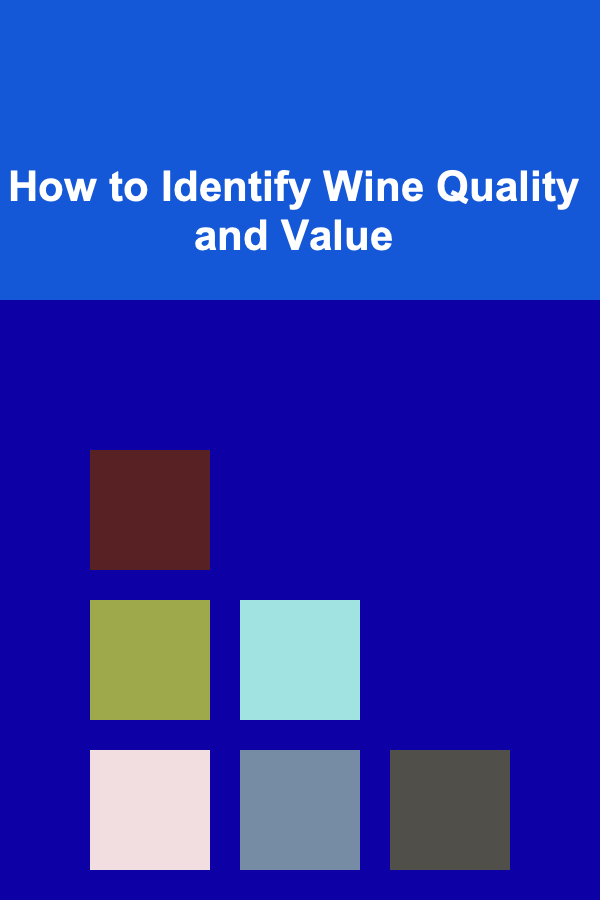
How to Identify Wine Quality and Value
ebook include PDF & Audio bundle (Micro Guide)
$12.99$10.99
Limited Time Offer! Order within the next:

Wine has captivated people for thousands of years. From the lush vineyards of Bordeaux to the rolling hills of Tuscany, it has been woven into culture, history, and tradition. However, with such a vast selection of wines available on the market, identifying the quality and value of a bottle can be a daunting task for both connoisseurs and beginners alike.
Understanding how to assess wine quality and its value involves a combination of sensory evaluation, knowledge of the wine's origins, and an awareness of its market worth. This article aims to provide a comprehensive guide to help you navigate the world of wine, giving you the tools to distinguish between a wine that is simply good and one that is exceptional in both quality and value.
Sensory Evaluation: The Heart of Wine Quality
When it comes to determining the quality of wine, the most important tool you have is your senses. A skilled taster can evaluate a wine through sight, smell, taste, and touch, identifying subtle nuances that might elude an untrained palate. To assess a wine's quality, it's crucial to develop a process of evaluation that engages all of your senses.
1. Sight: The First Impression
The first impression of a wine comes from its appearance. While it may seem superficial at first, the visual characteristics of a wine can reveal a lot about its age, clarity, and overall quality.
- Color: Wine color can tell you a great deal about its age and the type of grape used. White wines range from pale yellow to deep gold, with darker colors often indicating more mature wines or the use of oak barrels. Red wines, on the other hand, go from light ruby to deep garnet, with older reds often displaying brick-red or brownish hues.
- Clarity: A high-quality wine should be clear and free of any sediment or cloudiness (with a few exceptions for unfiltered wines). If a wine is hazy, it might indicate problems in the winemaking process or improper storage.
- Legs: When you swirl a wine in a glass, you may notice streaks of liquid running down the sides of the glass, known as "legs" or "tears." These can indicate the alcohol content and viscosity of the wine. While legs themselves don't directly correlate with quality, they can hint at the wine's body and richness.
2. Smell: The Aroma Profile
Smell is perhaps the most important sense when evaluating wine. The nose of a wine is where you will detect its complexity and potential for aging. A wine's aroma profile can tell you about the quality of the grapes, the fermentation process, and whether the wine has been well-made.
- Primary Aromas: These are the aromas derived directly from the grape itself. They can include fruity scents like berries, citrus, or tropical fruit, as well as floral notes like jasmine or rose.
- Secondary Aromas: These arise during fermentation and can indicate the presence of yeast, bread, or butter, especially in wines that have undergone malolactic fermentation.
- Tertiary Aromas: These are the aromas that develop as the wine ages. They can include earthy, leathery, nutty, or spicy notes, often indicative of the wine's maturity. Older wines may also display aromas of dried fruits, tobacco, or even forest floor.
An important part of wine evaluation is to ensure that the wine is free of faults. Off smells, such as vinegar-like aromas (which could suggest spoilage) or musty, moldy scents (indicative of cork taint), should raise red flags. A good wine will have a pleasant, inviting aroma that encourages you to take a deeper sip.
3. Taste: The Final Judgment
The true quality of a wine is revealed when it touches your palate. Tasting allows you to evaluate a wine's balance, complexity, and finish. The key components to focus on when tasting wine are sweetness, acidity, tannins, alcohol, and the overall flavor profile.
- Sweetness: Wines can range from bone-dry to very sweet. Sweetness comes from residual sugar left in the wine after fermentation. High-quality wines typically strike a balance between sweetness and dryness, with sweetness playing a supporting role rather than overpowering other elements.
- Acidity: Acidity is what gives wine its crisp, refreshing character. Wines with high acidity tend to taste more vibrant and lively, while those with low acidity can feel flat and dull. Acidity is essential for balance in many wine styles, particularly in whites and sparkling wines.
- Tannins: Tannins come from the skins, seeds, and stems of grapes and are most commonly found in red wines. They give the wine structure and astringency, and high-quality wines will have a firm tannin structure that integrates smoothly with the other elements.
- Alcohol: Alcohol content influences a wine's body and mouthfeel. While alcohol itself doesn't directly impact quality, an unbalanced wine with high or low alcohol may be a sign of poor craftsmanship. Ideally, alcohol should complement the other elements in the wine.
- Flavor Profile: The flavor profile is a combination of the fruit, floral, earthy, spicy, and other flavors that emerge as you taste the wine. High-quality wines have complexity and layers of flavors that evolve over time. A good wine will have a rich, harmonious profile that is interesting and well-balanced.
4. Touch: The Mouthfeel
The mouthfeel of a wine refers to the tactile sensations it gives in your mouth. Is it smooth and velvety, or is it rough and harsh? Does it feel heavy or light on the palate? These characteristics are influenced by tannins, alcohol, and other factors, and they can significantly contribute to the perceived quality of the wine.
5. Finish: The Aftertaste
After swallowing, the lingering taste of a wine---known as the finish---is another important indicator of quality. A long, pleasant finish is often a sign of a well-made, complex wine. A short or unpleasant finish might suggest a wine that lacks depth or balance.
Understanding Wine Quality: Factors That Influence It
In addition to sensory evaluation, understanding the factors that influence wine quality can help you determine whether a wine is of high caliber. These factors range from the vineyard's location to the winemaking process and the storage conditions.
1. Terroir: The Role of Location
Terroir is the French term used to describe the unique combination of environmental factors that affect the flavor and character of wine, including climate, soil type, and topography. The location of the vineyard plays a huge role in determining the quality of the grapes and, by extension, the quality of the wine.
- Climate: Grapes thrive in temperate climates, where they receive ample sunlight and have a balance between warm days and cool nights. Regions with extreme climates---either too hot or too cold---may struggle to produce high-quality grapes. For example, the cool climate of Burgundy is famous for producing world-class Pinot Noir and Chardonnay wines, while the warmth of Napa Valley is ideal for bold Cabernet Sauvignon wines.
- Soil: Different types of soil provide different minerals and nutrients to the grapevines. Well-drained soils, particularly those rich in limestone, clay, or gravel, can help produce grapes that yield complex and balanced wines. Poor soil conditions, however, can lead to wines that are underdeveloped or lack depth.
2. Winemaking Process
The way wine is made can greatly affect its final quality. High-quality winemakers carefully select the best grapes, handle them with care, and use time-tested techniques to ensure that each wine is crafted to its full potential.
- Grape Selection: Quality wine begins with quality grapes. Grapes that are harvested at the right moment of ripeness are crucial to making a high-quality wine. Overripe or underripe grapes can lead to undesirable flavors in the final product.
- Fermentation: The fermentation process can vary widely depending on the style of wine being produced. Some winemakers use stainless steel tanks, while others opt for oak barrels, which can impart subtle flavors to the wine. The length of fermentation and whether malolactic fermentation (a process that softens acidity) is used can also influence the final quality.
- Aging: Many wines improve with age, as the tannins soften and the flavors become more integrated. Wines that have been carefully aged in oak barrels can take on additional complexity and depth. However, not all wines benefit from aging; some are meant to be consumed fresh.
3. Storage Conditions
Once a wine is produced, its quality can be compromised by improper storage conditions. Wine should be stored in a cool, dark place, ideally at a consistent temperature. Excessive heat or light exposure can cause a wine to spoil or age prematurely. High-quality wines are typically bottled and sealed carefully to ensure that they can be stored for optimal aging.
Assessing Wine Value: Price vs. Quality
One of the most common questions wine drinkers ask is, "How do I know if a wine is worth the price?" While the quality of a wine is essential, it doesn't always correlate with its price tag. Understanding the factors that contribute to wine value can help you make smarter purchasing decisions.
1. Brand and Reputation
Wines from well-known wineries or regions (such as Bordeaux, Napa Valley, or Tuscany) tend to have a higher price tag, partly due to their reputation for producing high-quality wines. However, this doesn't mean that lesser-known wines aren't excellent. In fact, you might find exceptional wines from emerging regions or smaller wineries that offer better value for money.
2. Age and Rarity
Older wines, particularly those from great vintages or rare bottles, tend to increase in value. A wine's age can improve its complexity and flavor, but it also adds to its scarcity. If you're purchasing a wine for aging, the rarity and provenance of the bottle can affect its value over time.
3. Wine Reviews and Ratings
Wine critics and sommeliers offer valuable insights into a wine's quality. Wines that receive high ratings from reputable critics may be more expensive, but they can also represent excellent value, especially if you're looking for a standout bottle for a special occasion.
Conclusion
Identifying wine quality and value is both an art and a science. With practice, you can develop your sensory evaluation skills and understand the factors that influence a wine's excellence. Whether you're purchasing a bottle to enjoy now or adding to your cellar for future enjoyment, knowing how to assess wine will enhance your experience and help you make smarter choices. Wine is about more than just taste---it's about appreciating the craftsmanship, history, and terroir that go into every bottle.

Beginner Guide: The Guide to Mindful Living
Read More
How to Choose the Right Accessories for Home Staging
Read More
How To Master Email Marketing for Your POD Brand
Read More
How to Repurpose Old Furniture for Laundry Storage
Read More
How to Store Textbooks and Notebooks Effectively
Read More
How To Explore DNA Barcoding for Species Identification
Read MoreOther Products

Beginner Guide: The Guide to Mindful Living
Read More
How to Choose the Right Accessories for Home Staging
Read More
How To Master Email Marketing for Your POD Brand
Read More
How to Repurpose Old Furniture for Laundry Storage
Read More
How to Store Textbooks and Notebooks Effectively
Read More